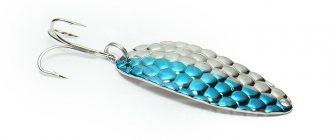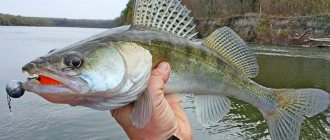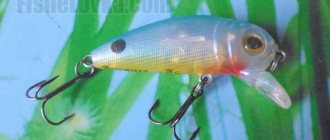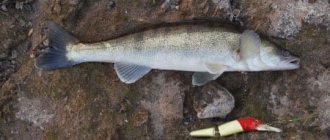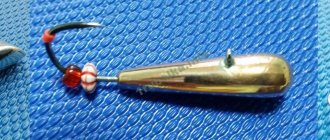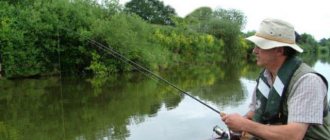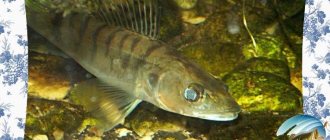Pike perch is the largest and most voracious representative of the perch family. It grows quite large in size, some individuals can reach more than 1 meter in length and weigh 10-15 kg. Although more often you should count on catching specimens weighing 1-5 kg. Fishing for pike perch from the shore is possible in fresh lakes and rivers of Eastern Europe and Asia, in the basins of rivers and lakes of the Black, Azov, Aral and Caspian seas, in rivers flowing into lakes Balkhash and Issyk-Kul.
Its body is elongated, laterally compressed and resembles a torpedo. The head is long and pointed, the mouth is studded with powerful fang-like teeth, and smaller ones are located between them. His eyes are bulging, bluish-gray in color. The body of pike perch has gray-brown spots, which often form 8-10 even transverse stripes. The back of the predator is colored greenish-gray, and the belly is white. There are rows of dark spots on the caudal and dorsal fins.
There are two forms of pike perch that differ in their lifestyle. Residential pike perch lives only in lakes and rivers, semi-anadromous pike perch lives in deltas of rivers flowing into seas, the water of which is brackish, and during spawning it rises upstream.
Catching pike perch from the shore, behavioral characteristics and choice of fishing location
Pike perch chooses reservoirs with clean running water, rich in oxygen, with a hard sandy, rocky or pebble bottom, so it is absent in oxbow lakes, bays (with the exception of post-spawning zhor) or silted rivers.
Small pike perches, like perches, lead a schooling lifestyle and stay in the coastal zone, near aquatic vegetation. Large individuals stand on the riverbed, in places with great depth or sharp changes in depth. Often these are snags and holes, to which rocky or sandy shallows come close. Pike perch likes to hunt near bridges and breakwaters, in places where rapids and dams create a reverse current, near sharp ledges of the shore, on the slopes of spits above and below the islands.
Very often, a school of pike perch appears near a school of bream, which cleans up after them the remains of dreisen shells, which are a great delicacy for the toothed predator. Therefore, in places where bream is actively fished, you can safely count on a pike perch bite.
In reservoirs and lakes, you should look for it on flooded river beds, near breakwaters, islands, bridges, in places where underwater hills create “tables.” Fishing for pike perch from the shore becomes more active closer to evening twilight, when pike perch approaches the coastal zone to feed. Active biting lasts up to 23-24 hours, after which it becomes weaker, but the chances of catching a toothed predator remain; with the onset of dawn, the biting resumes.
Zander
Catching pike perch from the shore begins after high water; it is especially successful in taking bait 10-15 days after spawning, which occurs when the water warms up to 7-8° degrees and falls in May - June, in southern latitudes April - May. At this time, you need to look for it in bays in shallow water near thickets of reeds and aquatic vegetation, where it feeds on spawning fish. With the onset of summer heat, the pike perch becomes lethargic and goes deeper and deeper into holes, but even there its bite is weak or absent. An exception may be days when the weather worsens sharply and becomes cool. With the onset of autumn and the decline in heat, the pike perch bite resumes.
Due to the fact that the pike perch has a narrow mouth, the basis of its diet consists of runaway aquatic inhabitants such as dace , bleak, ruff , gudgeon, so live bait from medium-sized crucian carp or bream is not the best option. Also, young pike can end up on the table of pike perch, and cases of cannibalism are not uncommon for this aquatic inhabitant. Unlike pike, pike perch does not chase fish, but prefers to attack from an ambush.
Catching pike perch from the shore is successfully carried out using a spinning rod, a donkey or a float rod.
Catching pike perch from the shore using a spinning rod
For coastal fishing for pike perch, a light rod with a test weight of 40 g is used; when the bite is active, spinning rods with a test weight of 60-70 g are chosen, this affects the sensitivity of the bite, but saves time when fishing. When the bite is weak, it is better to switch to lighter gear with a test in the range of 30-35 degrees, in this case there will be a greater chance of detecting a careful bite. In order to pierce a powerful jaw with a sharp and strong hook, use rods with fast and ultra-fast action.
Catching pike perch from the shore has its own requirements for the length of the spinning rod and depends on the casting distance, the presence of a current, and the bottom topography. Mostly they use spinning rods with a length of 2.4 to 3 m, but if you have a spinning rod of greater length and it is light enough so that you can cast and retrieve without much effort throughout the entire fishing, then you will only win. Using a long spinning rod on the edges and drops allows you to achieve a greater change in angle during step-by-step retrieving and increases the chances of releasing a bait caught on the bottom by horizontally raising the spinning rod to its full length or horizontally feeding it forward towards the edge. Also, when fishing in the current, when the line is carried to the side, hooking with a long spinning rod will make it possible to quickly select the line.
The fishing line is taken as a monk measuring 0.25 - 0.3 mm or braided 0.15 -0.2 mm. Monoline can produce more bites, but due to its tendency to stretch, it is not always possible to make a high-quality hook and break through a strong jaw, so when using a monk, you need to take one that is least susceptible to stretching.
Retractable leash for pike perch
A 0.2-0.25 mm metal monk leash, like for pike fishing, is of no use to us, since pike perch cannot bite through regular fishing line. An inertia-free spinning reel with a spool size of 2500-3000, a metal bracket when using braid and a rear clutch, which is easier to adjust when fishing.
The most common equipment are jigs of various modifications. Some of the most popular are the standard jig, the spinning jig and the jig-rig.
Twisters and vibrotails can be used as bait . If you fish in places where there is a lot of aquatic vegetation, then you are better off using spinnerbaits with artificial fish, or twisters and vibrating tails with an offset hook.
Also, catching pike perch from the shore is successful with oscillating spoons with a front landing 6-7 cm long, rather narrow ones no more than 1-2 cm wide. If you are fishing in coastal thickets, Ratlin- type wobbler with an elongated body shape and sinking or neutral Mannou will suit you.
Ratlin for zander
The bait is played mainly using a jig, 2-3 turns of the reel and a pause of 2-3 seconds, while the pike perch attacks more often when the bait falls than when it rises. From time to time it is worth making a short step of 0.5-1 revolution of the coil and 0.5-1 second of delay. Such wiring gives good results near small water edges, hummocks or bottom irregularities.
The bait is cast both perpendicular to the dump and brought from the depth to the rise aground, and at an acute angle to the left or right, so it rises from the depth to the top of the dump not perpendicularly, but obliquely. Quite often, when fishing at an angle, you can feel small spits that stand across the current; in these places, in addition to pike perch, successful fishing for pike or asp can occur. Fishing of the spit should begin from its beginning near the shore. In cases when the bait begins to rise upward under the influence of the current, you should reduce the number of revolutions of the reel when retrieving. A pike perch hooked on a hook does not offer much resistance when fished, so when biting it, the main thing is a sharp and powerful hook.
Tactics and fishing techniques
When a promising place has been identified, live bait should be caught. It is better not to stock up live bait for future use. They can be caught with a simple fishing rod.
Tips for fisherman: Do-it-yourself bottom tackle on the current - Features of choice
And you can use airplanes:
- top;
- screens;
- lifts;
- spiders.
Using such devices, you can easily catch the required number of live bait in a short period of time. Most of all, pike perch like small roach and bitterling. You need to attach live bait by two lips. This way it stays alive for a long time and will not fall off when casting the rig.
The equipment should be thrown to the farthest point of a promising location. Within ten minutes, an active predator will reveal itself. If there is no bite during this time, you should play with bait. You need to make two turns of the coil and wait a couple of seconds, then another turn. Then wait a minute and repeat everything. You need to continue this game until the bait leaves the promising place. If there is a fanged robber nearby, he will definitely show himself. Otherwise, you need to look for another suitable place.
This ancient fishing method is still an interesting and productive way of catching pike perch in our time.
Since this type of fishing does not apply to regular fishing, you need to choose the right place, and for this it is advisable to know where pike perch usually hangs. Spinners know such places, and in this sense it is easier for them. This method is used from the second half of June until the end of October. In mid-autumn you can take out the spinning rod again. The fish go to deeper places, so catching them with live bait becomes problematic. With the arrival of frost, the pike perch slides into holes.
Catching pike perch from the shore to the donk
For bottom fishing, strong plug rods 2.4-3 m long are used; spinning, match or feeder rods are perfect for these purposes. Fishing for pike perch can always present a surprise in view of successful catfish fishing , and in order not to be left without a catch, we need a strong fishing rod. The action of the rod should be fast or super fast. Since bottom fishing is not as maneuverable as spinning fishing, several rods are used, usually 3-4, which are used to fish at different depth levels. If the bite starts active, you can reduce their number to one. The fishing line used is a monk of 0.4 mm or a braid of 0.2-0.25 mm. Monk leashes are 50-70 cm long and 0.3 mm thick.
An inertia-free power reel with a spool size of 3000 and a metal bracket when using braid, rear clutch. You can also fish with inertial reels, but this is less productive. Catching pike perch from the shore to the bottom imposes its own requirements on the choice of sinker; its weight ranges from 50 to 150 grams, depending on the depth and casting distance. The load may be dull with a weight of 100 grams or more. and sliding limited by stoppers.
During the post-spawning period, when pike perch hunts in shallow water near aquatic vegetation, weights of 50 grams are used. and less. When fishing in a current, use flat weights in the shape of a spoon; in still water, round weights are suitable. The hooks are sharp and strong, No. 8-12, since we have to pierce a powerful oral cavity. The rods are installed at an obtuse angle to the water, and sound or light bite alarms are hung on the fishing line. Live bait is used as bait; it should be a fish characteristic of a given reservoir. They hook the bait fish by the upper dorsal fin. Live bait is bought or caught directly on the reservoir, so you need to remember the gear and baits to catch it. Re-casting time is 25-30 minutes.
Many feeder fishing enthusiasts catch pike perch using feeders as weights; the weight of the feeders is 80-120 grams. Standard bait for white fish is poured into the feeders; its presence will attract the attention of pike perch or breadcrumbs mixed with pieces of fish meat.
Fishing for pike perch on float tackle
Catching pike perch from the shore with float tackle has an advantage over donka in places with a heavily snag bottom or overgrown with aquatic vegetation. Take a strong rod, as for bottom fishing, 4-6 m long. Fast and super-fast action. A fishing line that is as little as possible stretched, a monk of 0.3 mm or a braided line of 0.15-0.25 mm. Habits are 15-20 cm long and 25 mm thick. The float must be sliding. To track the movement of pike perch after a bite, when it sinks the float, use a second float made of cork or foam plastic, fixed above the main one. The weight of the load for fishing in still water is 0.15 g, for fishing in currents 0.25-0.30 g. To reduce snags on snags, it is better to spread the load along the fishing line using pellets, rather than concentrating it, as happens when using olives.
Shipment-float
Power reel with spool size 2500 - 3000, with rear clutch.
Catching pike perch from the shore in still water is carried out in two ways, the first is when the weight is at the bottom, the second is when the live bait is placed at a depth of 15-30 cm from the bottom. If the place is not very snaggy, then you can periodically pull the bait towards you, creating a semblance of a game and fishing most of the territory.
During the current, they are caught in the wire, the float is carried away by the current, and the line smoothly unwinds from the spool, after a while the line stops and the float begins to sink, after the line is released and the float comes up, twitches and creates a game. When retrieving, the bait should go near the bottom.
The pike perch bites differently, it can immediately attack as soon as it sees the bait, or it can watch indecisively. If the pike perch does bite, it pulls its prey to the side, and in the current tries to go against it.
Choosing bait for pike perch
To catch pike perch, oscillating spoons, wobblers, foam fish, twisters and vibrotails are used.
But the best option is definitely jig baits. Twisters and vibrating tails are ideal for catching pike perch from the shore and work great for fanged fish. Twisters and vibrotails have several advantages. Firstly, these are budget baits that won’t hurt your pocket and don’t hurt as much when they break, as, for example, a wobbler or even a spinner. If you are a self-sufficient person and the financial part does not bother you at all, then the jig has one more, very important advantage - it is always in the attack zone of a predator. Jig baits are held near the bottom, making attractive movements for the predator. This is where pike perch hunts for its prey.
Size. It is optimal to choose silicone within the range of 6-13 cm. Typically, this length range is the most effective and catchable.
Color. When searching for a predator, be sure to offer him bait of different colors. He will react better to some, and worse to others. But you should not attach strong importance to shades. Typically, pike perch respond well to certain groups of colors:
- dark;
- light;
- bright;
- acidic.
Read How to salt pink salmon after freezing
Try dark colors; if there are no bites, change to a light or some acidic color. It has been noticed that pike perch often gives preference to these specific colors:
- orange;
- green with white;
- light green;
- yellow;
- citric.
Often does not mean always. These colors are not always effective. It happens that pike perch prefer purple baits or, for example, the color of machine oil or tea color. But the baits of the listed colors should prevail in your arsenal.
The best silicone baits for pike perch
To make it easier for a beginner to make a choice, the website ryba4ok.ru will name several silicone baits that work great for pike perch. The lures listed below are favorites for pike perch among experienced anglers, so they are truly worthwhile. Meet me.
- Bait Breath Mosya. This bait is a crustacean. Suitable for those who are familiar with fishing with passive rubber. Requires certain knowledge and game skills, since this bait itself does not have a game. The game is carried out by jerking, twitching and moving with the tip of the rod. Dragging along the bottom or blasting above the bottom with pauses work great. Pauses can be very long, pause when playing any game - dragging or twitching. The bait is edible, has an excellent aroma and attractiveness. A 1.5-2 inch bait will catch small pike perch; a larger predator will respond to a 3 inch bait. In addition, it works great on pike and perch. In principle, even a beginner can master the technique of dragging along the bottom with pauses, but you must be prepared for the fact that such retrieves are very long and not everyone has the patience to wait for pauses and slowly pull in the bait. Pauses when fishing with passive rubber should range from 2 to 10 seconds. Typically ten second pauses give the best results.
- Vibrating tail Manns Predator. And this is the active silicone that everyone is already familiar with, that is, one that can simply be applied evenly to create a game. But it’s still better to lead this bait with stepwise wiring. Manns Predator is incredibly catchy, but be careful, pike also attack it very often. The only disadvantages are the rather high price and low strength. The bait becomes unusable literally after a few bites. But, if the main thing for you is bites and catches, then these disadvantages can be ignored. The bait in green color with a black back showed itself best, and on different reservoirs. So, to begin with, it is better to purchase a vibrating tail in this particular color, and then experiment with other colors. Manns Predator is definitely one of the best silicones for zander.
- Reins Rockvibe Shad. This is not the most popular bait, but in a size of 3-4″ it just does its job well – catching walleye.
Excellent game, unique shape and ribbing easily provoke a predator to bite. The bait is edible, so when playing with long pauses, it is possible that even peaceful fish will bite. And if you take it in a size of 2″, you will be surprised how it kills perch, although you will only catch a very young zander. In general, silicone from Reins is currently one of the best, so even other models will work very well, but we still decided to recommend this particular model, which deserves the highest rating.
